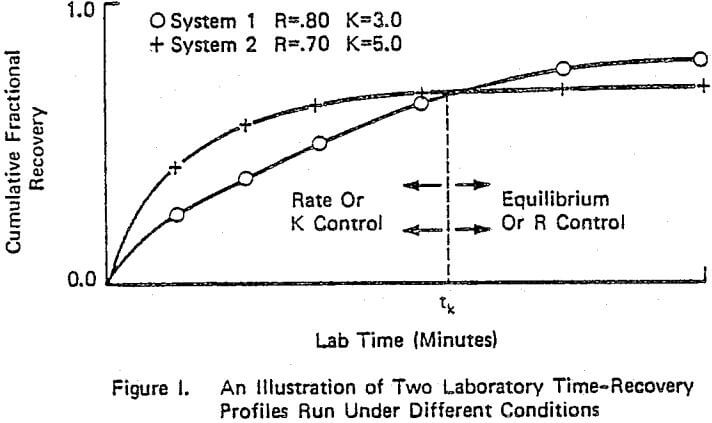It appears from all tests run to date that under otherwise constant conditions, increasing the concentration of a given collector increases R and decreases K in a uniform manner. This appears to be true for all collector types and is supported, e.g. by the data of Tables III and IV as well as Figure VIII from reference.
This observation has important implications in plant operations as it means that the excessive use of collectors can cause a bank of flotation cells normally operating in an equilibrium state (R is dominating) to actually pass into a state of mass removal limitation (K is dominating) with a subsequent drop in over-all plant recovery. Exactly such an occurrence has been demonstrated with several sulfide flotation plants throughout the world using xanthates as collectors.
Most collectors (including the xanthate family) do exhibit differences in R at more or less the same weight concentration of collector (which is well known). Table II demonstrates this quite well. The K values between collectors can also differ but for most of the collector species (especially the xanthates), the changes in K resulting from structural changes are relatively small, e.g. see Table II and Figure IX of reference. This indicates that most collectors are essentially rate insensitive when compared to each other.
For any given ore, however, there are usually several notable exceptions to the above statement. The collector Z-200 (isopropyl ethyl-thionocarbamate) consistently exhibits rates that can be double that of other collectors [see Table II and Figures VI, VII, and VIII of reference]. On some but not all ores, selected dithiophosphates also demonstrate superior rates of mass removal (see Table II). Further work in this area is being carried out by several research groups as almost all previous screening of collectors has been done based on the equilibrium recovery characteristics of the molecules involved. Rate enhancement due to improved collectors is important from an engineering viewpoint due to the more consistent and predictable behavior of collectors in plant operations compared to other flotation variables.
Thus, in summary, with the rate depressing phenomena of increasing collector dosage, the difference between a “high” rate collector and a “low” rate collector is merely the starting value of the K’s associated with each collector at low dosages. As more of each collector is added, the associated K values for each collector will drop in value with the “higher” rate collector having a higher K than the “lower” rate collector at the same dosage.


